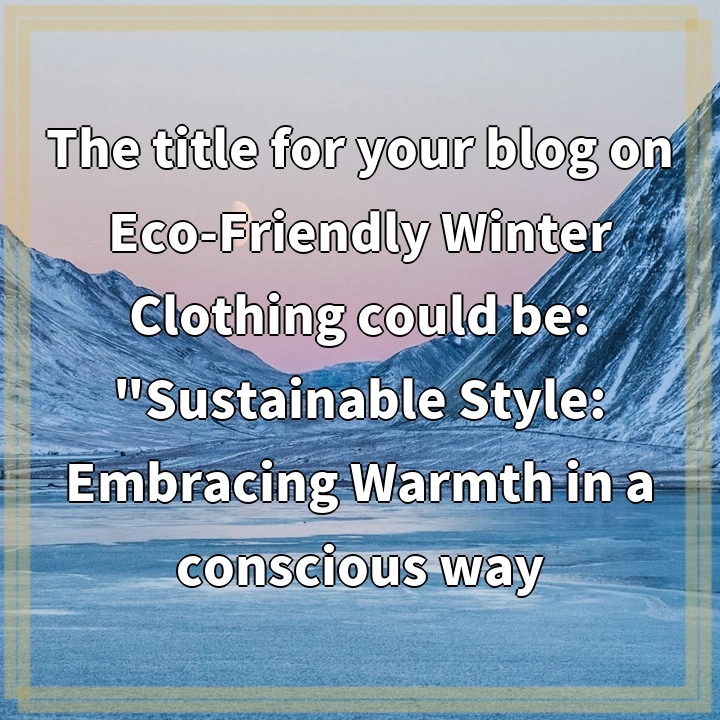Physical Address
304 North Cardinal St.
Dorchester Center, MA 02124
Physical Address
304 North Cardinal St.
Dorchester Center, MA 02124

Sustainable style is a growing trend in the fashion industry, focusing on eco-friendly and ethically produced clothing. When it comes to winter clothing, sustainable style means choosing garments that keep us warm while also considering their environmental and social impact.
While sustainable winter clothing is commendable, there are challenges that need to be addressed for a more sustainable and ethical fashion industry.
The availability and accessibility of sustainable winter clothing are limited. Although some sustainable fashion brands have emerged, they often come with a higher price tag, making them less accessible to the general population. Additionally, the design and style options may be limited, making it difficult for individuals to find products that align with their personal preferences.
The lack of transparency in supply chains and production processes is another challenge in the sustainable fashion industry. Some companies engage in greenwashing, making misleading claims about the sustainability of their products without providing concrete evidence. This makes it hard for consumers to differentiate between genuinely sustainable brands and those capitalizing on the demand for eco-friendly fashion.
The fast fashion culture perpetuates the idea of constantly updating one’s wardrobe to follow seasonal trends. This leads to increased consumption and disposal of clothing, contributing to environmental degradation. Sustainable winter clothing challenges this culture by promoting the idea of investing in high-quality, durable garments that can withstand multiple seasons. However, changing consumer attitudes and behaviors remains a significant hurdle in achieving this shift towards sustainability.
Many winter garments, especially those designed for warmth, are made from synthetic materials derived from fossil fuels, such as polyester and nylon. These materials have a negative environmental impact throughout their lifecycle. Moreover, when washed, synthetic materials release microplastic fibers into water bodies, contributing to the growing problem of microplastic pollution.
Addressing the challenges associated with sustainable winter clothing requires collective efforts from various stakeholders, including consumers, brands, and policymakers. Here are some solutions to create a more sustainable and ethical fashion industry:
Brands and retailers can work towards making sustainable winter clothing more accessible and affordable. This can be achieved by scaling up production, optimizing supply chains, and exploring innovative business models that prioritize sustainability without compromising on price. Collaboration with local artisans and communities can also promote unique and accessible options for consumers.
Greater transparency regarding supply chains and production processes is essential. Brands can adopt certifications, such as the Global Organic Textile Standard (GOTS) or Fairtrade certification, to provide assurance to consumers that their winter garments are produced ethically and sustainably. Supporting initiatives like Fashion Revolution’s “Who Made My Clothes” can encourage brands to disclose information about their supply chain, promoting transparency throughout the industry.
Consumer education plays a crucial role in promoting sustainable winter clothing. Brands can invest in educational campaigns to raise awareness about the environmental and social impact of fast fashion and the benefits of choosing sustainable alternatives. Sharing information about eco-friendly materials, responsible production practices, and the importance of extending the lifespan of winter garments empowers consumers to make conscious choices.
Transitioning towards a circular fashion economy can significantly reduce the environmental impact of winter clothing. Brands can innovate by implementing take-back programs, recycling initiatives, and designing garments that are easily repairable or upcyclable. Emphasizing the longevity and versatility of winter garments encourages consumers to opt for timeless and durable pieces, reducing the need for constant replacements.
Encouraging the use of sustainable materials, such as organic cotton, hemp, or recycled fibers, can help mitigate the environmental consequences of synthetic materials. Brands can partner with textile innovators to develop and invest in eco-friendly materials that maintain warmth without compromising on performance. Investing in research and development can lead to breakthroughs in sustainable textile options for winter clothing.
In conclusion, embracing eco-friendly winter clothing is a step towards a more sustainable and ethical fashion industry. By addressing the challenges and implementing solutions, we can make sustainable winter clothing more accessible, transparent, and environmentally friendly.
If you’re wondering where the article came from!
#